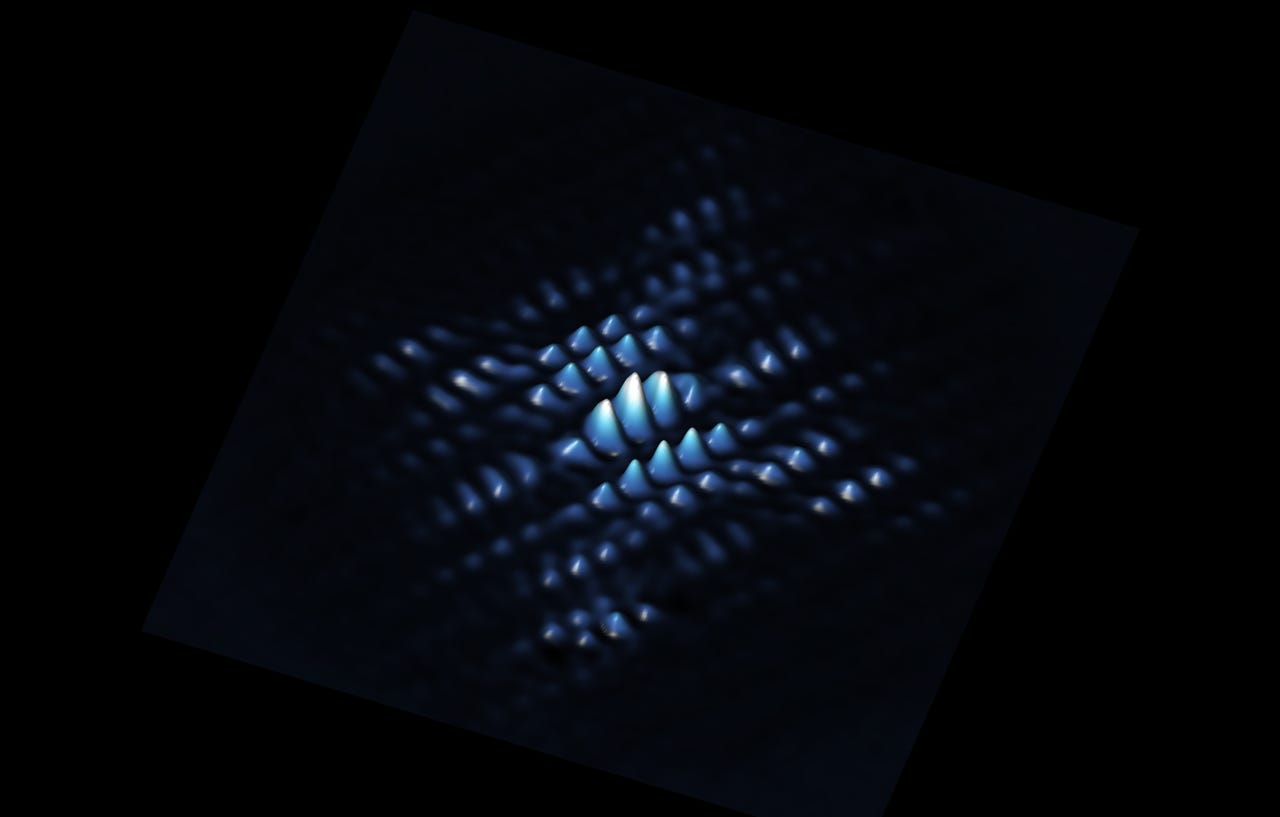UNSW makes atoms in silicon 'talk' in new quantum achievement


A scanning tunnelling microscope image showing the electron wave function of a qubit made from a phosphorus atom precisely positioned in silicon.
Scientists from the University of New South Wales (UNSW) have announced making two atom quantum bits (qubits) "talk" to each other in silicon, providing the ability to see their exact position in the solid state.
The team -- led by director of the Centre of Excellence for Quantum Computation and Communication Technology (CQC2T) and recent recipient of the Australian of the Year award UNSW Professor Michelle Simmons -- created the atom qubits by precisely positioning and encapsulating individual phosphorus atoms within a silicon chip.
The information is stored on the quantum spin of a single phosphorus electron, the university said.
"In placing our phosphorus atoms in the silicon to make a qubit, we have demonstrated that we can use a scanning probe to directly measure the atom's wave function, which tells us its exact physical location in the chip. We are the only group in the world who can actually see where our qubits are," Simmons explained in a statement.
"Our competitive advantage is that we can put our high-quality qubit where we want it in the chip, see what we've made, and then measure how it behaves. We can add another qubit nearby and see how the two wave functions interact. And then we can start to generate replicas of the devices we have created."
In realising the breakthrough, the team placed two qubits, one made of two phosphorus atoms and one made of a single phosphorus atom, 16 nanometres apart in a silicon chip.
Theory had predicted the two qubits would need to be placed 20 nanometres apart -- in the quantum world, a four nanometre improvement is a very big difference.
According to the university, using electrodes that were patterned onto the chip with similar precision techniques, the team was able to control the interactions between the two neighbouring qubits, resulting in the quantum spins of their electrons becoming correlated.
"This is a major milestone for the technology. These type of spin correlations are the precursor to the entangled states that are necessary for a quantum computer to function and carry out complex calculations," said study lead co-author Dr Matthew Broome, formerly of UNSW and now at the University of Copenhagen.
There's a big race internationally to build the first quantum computer and Simmons believes Australia can get there first. UNSW scientists and engineers at CQC2T are developing parallel patented approaches using single atom and quantum dot qubits.
"Our hope is that both approaches will work well. That would be terrific for Australia," Simmons said.
Simmons and her teams have been reaching for the finish line since 2000, developing their first qubit in 2012.
A team of researchers she led unlocked the key to enabling quantum computer coding in silicon in late 2015, announcing that UNSW had the capability to write and manipulate a quantum version of computer code using two qubits in a silicon microchip.
The breakthrough followed on from an announcement made a month prior when another team of engineers from the university built a quantum logic gate in silicon, which made calculations between two qubits of information possible.
By optimising their nano-manufacturing process, Simmons' team has also recently created quantum circuitry with the lowest recorded electrical noise of any semiconductor device.
Additionally, they created an electron spin qubit with the longest lifetime ever reported in a nano-electric device of 30 seconds.
"The combined results from these three research papers confirm the extremely promising prospects for building multi-qubit systems using our atom qubits," Simmons added on Wednesday.
NSW government proposes Quantum Academy
On Tuesday, the New South Wales government proposed the establishment of a Sydney Quantum Academy, a city-wide initiative led by the University of Sydney (USyd) in partnership with Macquarie University, UNSW, and University of Technology, Sydney.
USyd deputy vice-chancellor (Research) professor Duncan Ivison said a Sydney Quantum Academy dedicated to postgraduate training and research would help Sydney cement its place as a global centre of excellence for quantum technology.
"A Quantum Academy will also act as a magnet for outstanding global talent and help develop the next generation of quantum engineers," professor Ivison said.
More on quantum computing
- Australia's ambitious plan to win the quantum race
- UNSW unveils complete design of a silicon quantum computer chip
- Flip-flop qubits: UNSW conceives 'radical' quantum computing design
- UNSW unlocks key to quantum coding in silicon
- Silicon Quantum Computing launched to commercialise UNSW quantum work
- Sydney Uni predicts the unpredictable in quantum computing advancement
- University of Sydney receives quantum computing grant from US intelligence
- Commonwealth Bank prepares for quantum computing with launch of QxBranch simulator
- IBM's big quantum push: Samsung, Daimler sign up for 20-qubit test drive
- Microsoft and USyd claim invention of key quantum computing component
- Microsoft deepens University of Sydney quantum research partnership
- Intel, QuTech work on 17-qubit quantum computing chip, packaging
- How quantum computing could create unbreakable encryption and save the future of cybersecurity(TechRepublic)
- How AI and machine learning will help the rise of quantum computing (TechRepublic)